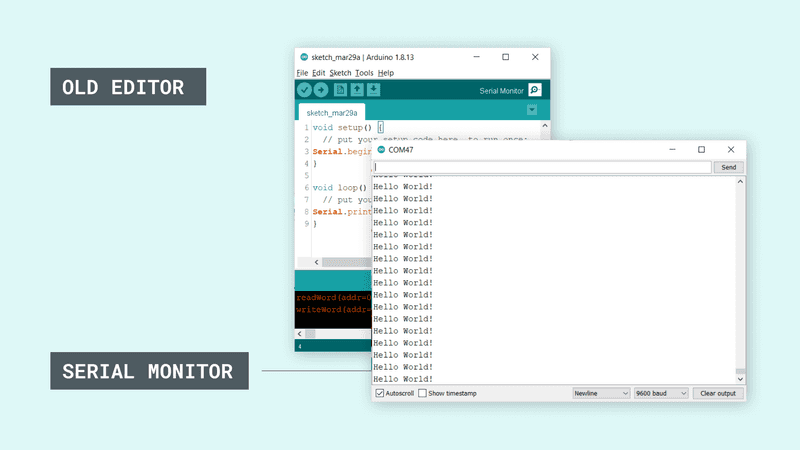- Check if the Serial Transmission Is Done or Not Using the Serial.flush Function in Arduino When we transmit data from serial, the data is placed in a buffer, and the program moves to the next statement, and the data is transmitted slowly from the buffer because serial is slow.
- I believe the Arduino IDE does not have full terminal emulation, so you can't clear it (normally you can clear with 'Esc') 2. 5y uno, nano, nodemcu v2. No, the Arduino IDE is fairly limited for debugging. Closest thing to clear screen would probably be printing a bunch of empty spaces/lines lol.

It is not clear what do you really want to do. Anyway, please note: In your C# code, if you enter, for instance, '1' in your TextBox then four bytes are sent to the serial line: three 0s and a single 1 (the 0s won't be handled by your Arduino code). In your Arduino code you didn't check if Serial.read returns -1 (i.e. No data available). Serial.write(27); // ESC command Serial.print('2J'); // clear screen command Serial.write(27); Serial.print('H'); // cursor to home command But it doesn't work. I also found a solution like Serial.println; but that solution (cheat as they called it) will only work on a serial monitor. So is there any possible solution to clear the display. Created on: 2 August 2012Clear Serial Monitor Arduino DownloadHow To Clear Serial Monitor ArduinoThe Arduino Uno can send data (such as a text message) to the PC over the USB cable. ComponentsAll that is needed is an Arduino Uno board, standard USB cable and PC with the Arduino IDE software installed.
Description


Used for communication between the Arduino board and a computer or other devices. All Arduino boards have at least one serial port (also known as a UART or USART), and some have several.
Arduino Clear Serial Input
| Board | USB CDC name | Serial pins | Serial1 pins | Serial2 pins | Serial3 pins |
|---|---|---|---|---|---|
Uno, Nano, Mini | 0(RX), 1(TX) | ||||
Mega | 0(RX), 1(TX) | 19(RX), 18(TX) | 17(RX), 16(TX) | 15(RX), 14(TX) | |
Leonardo, Micro, Yún | Serial | 0(RX), 1(TX) | |||
Uno WiFi Rev.2 | Connected to USB | 0(RX), 1(TX) | Connected to NINA | ||
MKR boards | Serial | 13(RX), 14(TX) | |||
Zero | SerialUSB (Native USB Port only) | Connected to Programming Port | 0(RX), 1(TX) | ||
Due | SerialUSB (Native USB Port only) | 0(RX), 1(TX) | 19(RX), 18(TX) | 17(RX), 16(TX) | 15(RX), 14(TX) |
101 | Serial | 0(RX), 1(TX) |
On Uno, Nano, Mini, and Mega, pins 0 and 1 are used for communication with the computer. Connecting anything to these pins can interfere with that communication, including causing failed uploads to the board.
You can use the Arduino environment’s built-in serial monitor to communicate with an Arduino board. Click the serial monitor button in the toolbar and select the same baud rate used in the call to begin().
Serial communication on pins TX/RX uses TTL logic levels (5V or 3.3V depending on the board). Don’t connect these pins directly to an RS232 serial port; they operate at +/- 12V and can damage your Arduino board.
Arduino Clear Serial Port
To use these extra serial ports to communicate with your personal computer, you will need an additional USB-to-serial adaptor, as they are not connected to the Mega’s USB-to-serial adaptor. To use them to communicate with an external TTL serial device, connect the TX pin to your device’s RX pin, the RX to your device’s TX pin, and the ground of your Mega to your device’s ground.